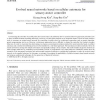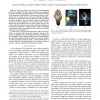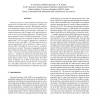26 search results - page 4 / 6 » What Robots Can Do: Robot Programs and Effective Achievabili... |
IJON
2006
13 years 6 months ago
2006
Constructing the controller of a mobile robot has several issues to be addressed: how to automate behavior generation procedure, how to insert available domain knowledge effective...
IJSE
2010
13 years 3 months ago
2010
Affective computing has proven to be a viable field of research comprised of a large number of multidisciplinary researchers resulting in work that is widely published. The majori...
ICRA
2009
IEEE
14 years 26 days ago
2009
IEEE
— The state-of-the-art in control of hand prosthetics is far from optimal. The main control interface is represented by surface electromyography (EMG): the activation potentials ...
CDC
2009
IEEE
13 years 11 months ago
2009
IEEE
— Control saturation is an important limitation in practical control systems and it is well known that performance degradation or instability may result if this limitation is not...
DATE
2003
IEEE
13 years 11 months ago
2003
IEEE
Instruction reuse is a microarchitectural technique that improves the execution time of a program by removing redundant computations at run-time. Although this is the job of an op...



